Did Congress Declare Pizza A Vegetable? Not Really
Another meme debunked, plus some thoughts on policy.
Twitter, the punditocracy, the blogsophere, and late night television had a lot of fun last week with a decision in Congress that purportedly declared pizza to be a vegetable so long as it contained a minimal amount of tomato sauce. As James Joyner noted at the time, this wasn’t really “news” so much as it was a continuation of existing policy regarding nutritional standards. Today, Sarah Kliff notes that the “pizza as a vegetable” meme isn’t really true at all and that when you look at the facts, Congress didn’t really make the kind of egregious nutritional error that some critics have accused them of:
This is not a fight over pizza. It is, instead, a fight about tomato paste. Specifically, it’s a fight about how much of the product counts as one serving of vegetables.
Right now, tomato paste gets a sort of special treatment under school lunch regulations. Just “an eighth of a cup of tomato paste is credited with as much nutritional value as half a cup of vegetables,” my colleague Dina ElBoghdady explained last week.
The Obama administration guidelines, outlined in January, would have nixed tomato paste’s extra credit, counting a half cup as a half cup. “Under this proposal, schools would credit tomato paste and puree based on actual volume as served,” the regulation, published in the Federal Register on Jan. 13, 2011, explains. “Schools would not be allowed to credit a volume of fruits or vegetables that is more than the actual serving size.”
What happened this week was that Congress blocked that change: Tomato paste will continue to get outsized credit, with one-eighth of a cup essentially counted as something four times larger.
This makes it easier, and cheaper, for pizza manufacturers to produce a product that includes a serving of vegetables. But it by no means declares the pizza itself a vegetable. Schools lunches are still measured by federal regulations for calories (no more than one-third of daily recommended value) and fat content (less than 30 percent of the meal), which limits how much pizza students can be served. A cafeteria worker can’t just pile a slice of pizza on a plate and say she’s serving salad.
Perhaps most the most interesting part of Kliff’s column, though, is when he compares the nutritional value of 1/8 of a cup of tomato paste with a larger serving of fruit:
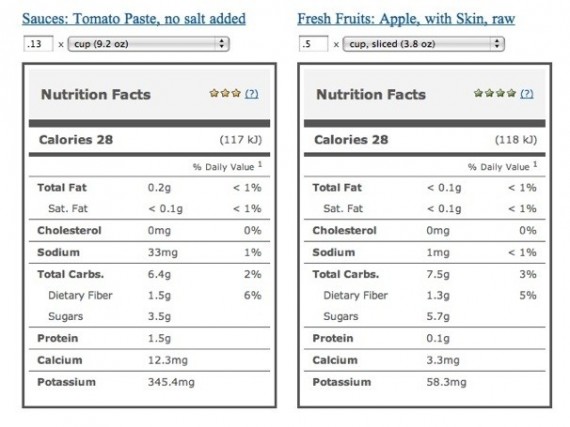 So when you look at the facts, that small serving of tomato paste is actually more nutritious than a half-cup of sliced apples. There’s slightly more sodium in the tomato paste, but not an egregiously large amount. On the whole then, giving some special recognition to tomato paste may not be a bad idea at all. In either case, though, what’s clear is that, despite the headlines, Congress did not declare pizza to be a vegetable.
So when you look at the facts, that small serving of tomato paste is actually more nutritious than a half-cup of sliced apples. There’s slightly more sodium in the tomato paste, but not an egregiously large amount. On the whole then, giving some special recognition to tomato paste may not be a bad idea at all. In either case, though, what’s clear is that, despite the headlines, Congress did not declare pizza to be a vegetable.
All of this brings up another question, of course, and that’s whether bureaucrats in Washington, or Members of Congress, should be determining the contents of school lunches for a nation the size of the United States. That’s not a new development, of course, it’s been a part of school lunches in this country since the 1960s when Congress first started subsidizing meals for lower-income children. Even if you agree that this is a good idea, though, that doesn’t mean that Congress, or the Department of Agriculture should be in the business of deciding what’s for lunch in Ottumwa, Iowa public schools. One of the biggest results of that fact has been the result that school lunches in this country are essentially catered by a handful of companies who are able to lobby Congress for program changes that benefit their interests. If centralized control had not been put in place along with the centralized funding, then it’s probable that this concentration in the industry would not have occurred. So, instead of the system we have now, we could replace it with block grants to the states and let them set the standards. It can’t be any worse than what we have now.
Note: Post updated to reflect that the linked article was written by Wonkbook contributor Sarah Kliff, not Ezra Klein.
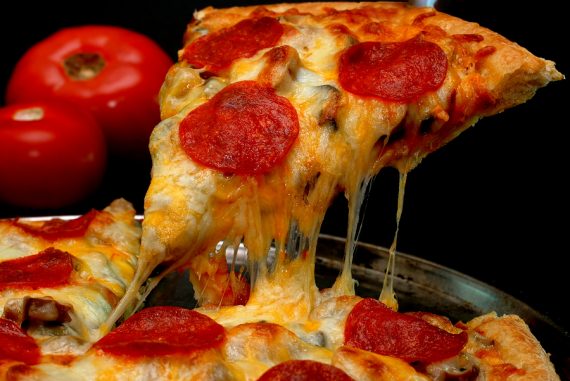

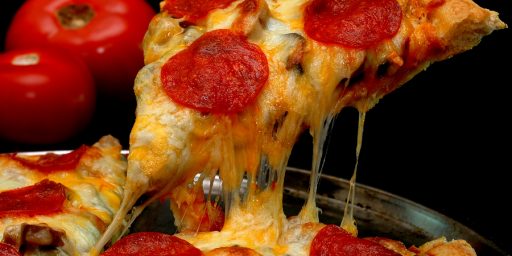
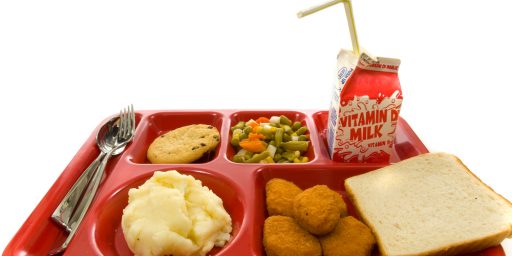

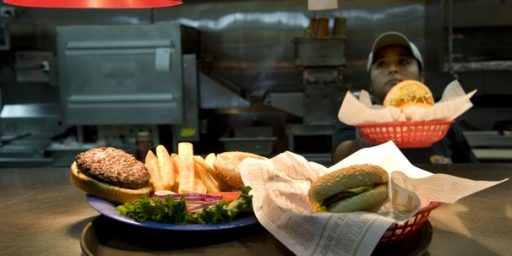
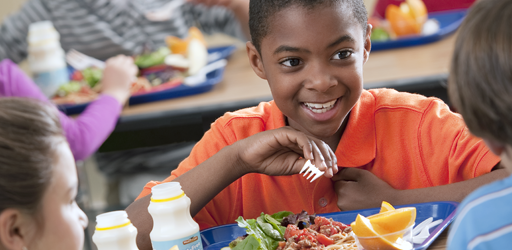
Why not? It’s not as if there is significant regional variation in what constitutes nutritious food for an 8-year-old.
States are free to set higher standards for school lunches — the federal standards are minimums. Take away those minimums, and the result (at least in some states) could well be worse than what we have right now.
This probably started back in the Reagan era, Ketchup as a vegetable debate
http://en.wikipedia.org/wiki/Ketchup_as_a_vegetable
@rodney dill:
Yea, another meme that isn’t true.
@Doug Mataconis: What part isn’t true? That these are linked? The wikipedia entry on ketchup as a vegetable? You’re likely right, I just don’t understand your response.
I think that part of this issue here, apart from the pizza meme itself, is that this is seen as a) an example of lobbyist getting their way on an issue, and b) Congress’ ability to deal with small stuff, but its utter inability to deal within of significance.
Indeed, it fits the narrative of the day: Congress can do what lobbyists want, but can’t make policies useful for the broader population (like, you know, passing a functional budget or acting like grownups on the deficit).
@ SLT…
Spot on.
Luckily Grover Norquist isn’t working for the vegetable lobby…or that never would have gotten done either.
Basically Doug says that if you follow the logic of the scam, you lose track of the scam.
Yes, pizza is now a vegetable because there is a “nutrition accounting path” to make it so, based on, as he says, a special tomato paste credit.
This despite the fact that “tomato paste” may contain less “tomato” than you think.
So … as you eat that frozen cardboard slice of pizza fuggetaboutit … it’s a vegetable!
(By the same logic Bernie Madoff wasn’t running a scam, because he planed on paying you back … really.)
(And GOOD GOD, let’s compare tomatoes to apples by all means!)
Tomato is a fruit, not a vegetable 😉
@john personna: Which is sort of comparing apples and oranges.
@rodney dill:
Anyone who knows anything about nutrition knows that apples are a sugar and fiber source, and that’s about it. It’s actually one of the scandals that government programs push apple juice, which is pretty much just a sugar source.
So if whoever made the tomato paste versus apples choice knew that (could they not?) then they were totally slagging their audience.
My nomination for “Clueless Line of the Day”. 33 times the amount of salt is not egregiously more…. Doug, I gotta hand it to you, that was good for a long laugh.
Also, the chart lumps all sugars together. Not all sugars are equal and I would give 10-1 odds that the “Sugars” in tomato sauce is high fructose corn syrup. Not so good for you.
@john personna: Sorry, I used your first tomato/apples comparision comment to just pun on an apples to oranges comparision.
@OzarkHillbilly:
The sugar in tomato past most likely comes from the, umm, sugars in the tomato itself too, you know.
Also, as the nutritional label shows, the amount of sodium is still just 1% of the RDA
@rodney dill:
No problem. Just leveraging from there to “oranges have vitamins.” 😉
I also thought the apple-comparison seemed to be a bit of barrier lowering. The problem for kids lunches is in the vegetables. And while I think my kids eat healthy, they tend to not like how others prepare vegetables.
@Doug Mataconis:
Is there a standard? Are you assuming a good, as opposed to a cheap, source of tomato paste?
Dollars to doughnuts, within a year after this change was instituted, brown kids in AZ would be getting the “Sheriff Joe Special” for lunch which would consist of Nutraloaf on the cheapest Wonder Bread knockoff available. And Alabama would be so friggin’ envious, those johnny-come-latelys.
Perhaps child nutrition is not an area we want to explore as a “race to the bottom” candidate. Dumb-ass.
@Doug Mataconis:
Right you are Doug. Instead of continuing to assert something w/o basis, I decided to get a can of paste and a can of sauce. 0 corn syrup added.
Is somewhat disingenuous. It is not as tho one is scraping off the tomato paste and eating only that, you are also eating everything else, like that nice salty mozzarella cheese, (13% per 1/3 cup)(not sure how much is on a slice, 1/2 that? 1/3? still adds up) or maybe a few slices of nice salty pepperoni? (no pepperoni in the fridge but for chorizo it is 25% per 2.5 oz serving again dividing it down to a per slice of pizza is problematic…)
The overall point is that to compare 1/8 cup of tomato paste to a 1/2 cup of apples is not that it is comparing apples to tomatoes, it is that it is just plain stupid. Processed foods nearly always contain way more salt than their combined ingredients, and we all of us get way too much salt.
@john personna:
You can’t google? Tomato paste is defined in 21 CFR 155.191
Nutritive sweeteners are part of the definition. You are thinking of catsup, which MSM doesn’t want to bring up as it leads to John Kerry and the Heinz fortune.
Tomato paste is concentrated tomatoes with a defined 24% tomato soluble solids.
@JKB:
are not part of the definition
@JKB:
Thank you. I did a casual google but didn’t come up with the CFR. It does seem tomato paste is pretty much the straight stuff. And so it comes down to whether the 4:1 advantage the paste enjoys over fresh vegetables is justified.
Re “that small serving of tomato paste is actually more nutritious than a half-cup of sliced apples”
A small serving of steak is actually more nutritious than a half-cup of sliced apples to given the “right criteria”.
The deal for me is not how far Congress and the Executive Branch drills down in determining nutritious value of school lunch food but the fact they are so deeply involved in school lunches in the first place. The federal government is way too involved in people’s life as it is.
FWIW, young people with adequate hydration should have no fear of sodium.
And those of us who hike, run, or bike, know we need more. It’s kind of amazing getting in the shower after exercise and tasting the salt washing out of your hair. More amazing than gross, actually 😉
(Adequate but by no means “significant” hydration, lol)
@JKB:
WTF? Is this some new thing or is it recycled BS from 2004? If you’re going to allude to some nefarious conspiracy, please provide a modicum of information.
Perhaps you’re referring to this?
http://www.snopes.com/politics/kerry/heinz.asp
yes they did this tomato paste doesn’t come on it own it comes attach to pizza
You all do realize a tomato is a fruit right? The congress saying any amount of vegetable is required in the tomato paste is pure stupidity in itself.